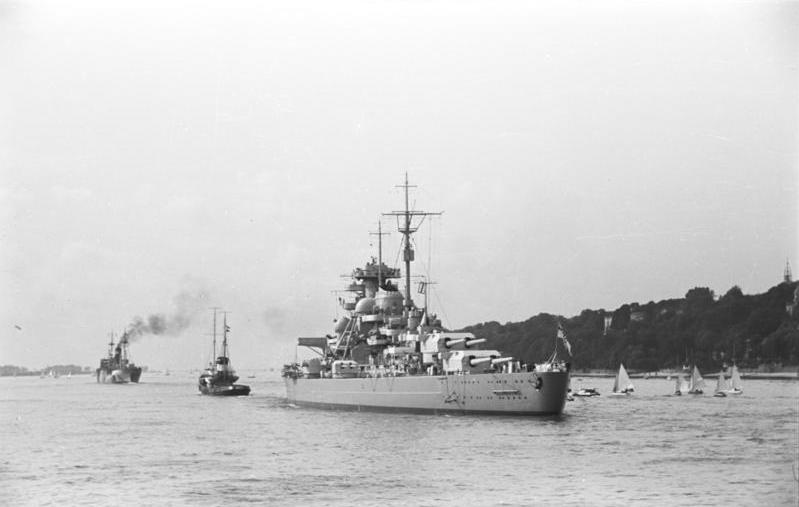The Battle of the Atlantic
When Germany began constructing two Bismarck class battleships in 1936, Britain was not worried, as a treaty formed in WW1 stated that Germany could not own any battleships that could challenge France and Great Britain.
One year prior in 1935, Hitler had even voluntarily agreed to limit the total tonnage of his navy, the Kriegsmarine, to 35 per cent of the Royal Navy’s tonnage.
However, the launch of the first new battleship in February 1939 showed that not only had Hitler disregarded the treaty, but the Bismarck class was something the world had never seen before. Christened Bismarck by the granddaughter of Otto von Bismarck, Germany’s first Chancellor, the ship was, like its twin the Tirpitz, 251m long and 36m wide. It was in fact larger than anything the British or French had. Its eight 38cm guns, placed in four twin-turrets were the biggest guns ever placed on a German warship. Additional medium artillery and anti-aircraft guns completed the armaments, while its rangefinder was top of the line.
But it was not just strong offensively. If it were to go toe to toe with French battleships, as had seemed the most logical enemy in 1936, it had to be able to withstand some hits without going down. The main armour belt was up to 32cm of super-strong Wotan-steel. Its double-walled hull could absorb the shock from a torpedo and disperse it around the hull. The transverse bulkhead was between 11-22cm thick and was segmented into 22 compartments that could be individually sealed in case of flooding. Its 12 high pressure boilers and its munition-chambers had an additional amour strength of 8-12cm. All in all, with 44 per cent of its weight dedicated to defence, it seemed impossible that this ship could be sunk.

By the time the ship was officially commissioned on August 24, 1940, the war had turned Europe upside down, and it was British shipping, not French, that was considered the main enemy at sea. The German invasion of Norway had deprived the British of strategic positions in the North Sea, and if the German battleships, the Scharnhorst and the Gneisenau, could combine their strength with both the Bismarck and the Tirpitz, it would mean a daunting German battlegroup for the British to tackle. And as the battle for Britain raged in the air, German submarines targeted shipping in the Atlantic, Britain’s lifeline. If such a battlegroup joined the hunt for freighters bound for Britain, Britain could be starved into submission. Food rationing had already been imposed on the British public, and the German subs, operating from nearby French harbours, sank over 260,000 tons of shipping in August alone.
This was exactly what Admiral Erich Raeder of the Kriegsmarine had in mind when he gave command of the Bismarck to Admiral Günther Lütjens. Second in command was Ernst Lindemann. The crew was made up of 2,000 volunteers from all over Germany, and they were top-grade men. In the Baltic Sea, the Bismarck had its first training exercise against a mock Hood battlecruiser. The HMS Hood, built at the end of the Great War, was for a long time the British flagship and symbolised the might of the Royal Navy.
The first tests were favourable. The Bismarck could reach a top speed of 30.8 knots and outrun any potential threat, but there were two weaknesses. The first weakness was that the recoil of the heavy guns was extreme, and it was uncertain if under combat conditions, the force of the naval guns firing would harm the ship’s equipment. The second weakness made itself known during a simulated rudder failure. Without rudders, it was very hard to manoeuvre the ship. Rudders and propellers were always a weakness on any ship though, and the admiralty dismissed the problem as the likelihood of a rudder taking a hit during combat was low.
The secret mission
By April 1941, the Bismarck was ready for combat. It was to head back to the North Sea, catch up with the heavy cruiser Prinz Eugen and meet Gneisenau in the Atlantic. Raeder gave the order that over the following three months, it was to sink as many freighters as possible. The might of the Bismarck would even allow the battle group to attack guarded convoys. However, at the time, both the Gneisenau and Prinz Eugen were damaged and awaiting repairs.
The Bismarck waited. On May 5, Adolf Hitler visited the ship. He was a fan of battleships. He loved the design but had no knowledge of tactical or strategic naval warfare. He was, however, fearful when it came to naval operations. On the one hand he wanted to protect and enhance the propaganda image of the mighty German forces but on the other, he wanted to avoid agitating the neutral Americans and their freight shipping. So, the Kriegsmarine kept Hitler in the dark about their plans.
On August 18, the Bismarck and Prinz Eugen were to secretly head into the Atlantic. The two ships were strong enough to do some serious damage to British trade. It was likely that the British knew that the Bismarck was battle ready, but still, secrecy was the key to success. Until they reached the Atlantic, the Bismarck could run into a British trap and be overwhelmed by numerically superior forces, but how they hoped to keep the largest battleship in the world floating around out there a secret, is a mystery.
On the 20th, the Bismarck was spotted and a day later members of the Norwegian resistance observed the German ships hiding in the fjords. They informed the British. Admiral Sir John Tovey aboard the new Flagship King George V, was Chief of the British Home Fleet. He was ordered by the British admiralty to locate and engage the Bismarck – that ship was not to reach the Atlantic. Tovey could not know the exact route the Bismarck would take, so he ordered Vice Admiral Lancelot Holland to take the Hood and make for Iceland with the HMS Prince of Wales to cut off the most likely path.
Back home, the Kriegsmarine informed Hitler about Bismarck’s departure on the 23rd. Hitler was furious and wanted to recall the ship, fearing that the Pride of Germany might be destroyed, but Raeder assured him that everything was fine, especially now that the German invasion plans for Crete were being finalised. The Bismarck would keep the British from sending additional ships into the Mediterranean.

Spotted again by the evening, two British heavy cruisers, the Suffolk and the Norfolk, had picked up on its scent. The Suffolk was equipped with a superior new radar system and the heavy cruisers shadowed the Bismarck and gave its whereabouts to the rest of the British fleet. The Bismarck seemed also to be pursued by bad luck. Not only could they not evade the new radar system, but the first time they fired on the pursuing heavy cruisers, the recoil of the guns damaged their own radar system, so they had no idea what was heading their way.
It was the Hood and the Prince of Wales. The Hood had more guns than the Bismarck but much less armour. The crew was also inexperienced because since the end of WW1, it had not fired a shot in combat. The battleships closed in on each other. The first to draw blood was the Prinz Eugen, hitting one of the Hood’s munition chambers, and then, just as the Hood was turning to bring its aft guns to bear, the fourth salvo from the Bismarck smashed into it, punching through its armour and detonating inside the ship’s main munition chamber. A moment of shock paused the battle, as the HMS Hood was engulfed by a giant fireball and split in half. The Prince of Wales returned fire on the Bismarck, damaging it, but was in turn hit, which destroyed the bridge and killed the officers. The Prince of Wales turned tail and fled. Admiral Lütjens decided not to pursue but to check the damage on the Bismarck. It had only received one hit but was taking on water. One of the boiler rooms had to be abandoned but more importantly, the foremost fuel depots were leaking.
The end of Bismarck
Lütjens evaluated his options. He had damaged the Prince of Wales and destroyed the Hood, a major victory. Indeed, it had been a lucky shot and the battle had not lasted 10 minutes. Only three of 1,419 men aboard the Hood had survived. The Bismarck could no longer reach top speed and its fuel was lower than planned. Lutjens could return the way he came to Norway or attempt to break through to St. Nazaire in France for repairs. He chose France.
The death of the Hood was indeed a shock to the British public. Admiral Tovey was ordered to destroy the Bismarck with all ships available. Norfolk and Suffolk were still shadowing the Bismarck but neither could slow it down. The only ships close enough to do that were Force H – HMS Sheffield, HMS Renown and the aircraft carrier, Ark Royal, with 18 Swordfish torpedo bombers aboard. Those biplanes resembled World War I, but could reach 100 knots, enough speed to catch the Bismarck.
Lütjens was pessimistic about his chances since the whole British Home Fleet was on his heels. Force H made contact with the Bismarck on May 25, but the HMS Renown and the HMS Sheffield were too weak to engage. 15 torpedo bombers did instead. Such small planes were hard to hit with AA guns, especially at night, and with suicidal bravery they closed in and released torpedoes at 300m. The first torpedoes inflicted only minimal damage, but Bismarck was hit in the stern making evasive manoeuvres, and inrushing water blocked the rudder. Bismarck’s Achilles heel had been hit.
Engineers tried desperately to find a solution, but the water pressure was too high to send in mechanics. The situation seemed hopeless, as the British ships closed in. Admiral Lütjens radioed Berlin: “Ship disabled. We will fight to the last shell. Long live the Führer.”
Tovey planned to engage the Bismarck from all sides, with the battleships King George V and Rodney attacking from the west, while the Norfolk would come from the North and the heavy cruiser Dorsetshire would attack from the East.
In the early morning of the 27th, they sighted the slowly swaying Bismarck. Rodney and George V opened fire. Bismarck returned fire, but soon, two of its turrets were knocked out of action. A shell hit the artillery command centre, killing the officers. Bismarck was blinded. The shelling continued and by 09:15, Birmarck was a burning wreck. It fired its final shots just after 09:30, as its last turrets were destroyed.
The Bismarck was done. Of the 2,876 shells fired at it, 400 hit the ship in a little over half an hour. Aboard the ship it was pure hell, from poisonous gases, fire, heat, cold water, oil and blood from the dead and the dying. At 10:15 Lindemann, since Lütjens was probably dead at that point, gave the order to abandon ship. The men who could, did, as shells rained down, killing hundreds of sailors. The Dorsetshire fired three torpedoes as the final blow. Bismarck disappeared beneath the waves at 10:40. Just 115 of its crew survived.
Hitler learned about the disaster not from Admiral Raeder, but from the British press. The Kriegsmarine had refrained from telling him the truth, fearing his anger. And so, the brief adventures of the Bismarck, the mightiest battleship of all, ended.
The story of this fearsome German battleship heavily inspired our song ‘Bismarck‘. Take a look at the lyrics we wrote here.
If you prefer a visual representation of this story, watch our Sabaton History episode on Bismarck and the Battle of the Atlantic:





















